Valentino Balboni, a lifetime as a Lamborghini test driver
A test driver, or “collaudatore”, has the task of testing cars before delivering them to customers. Prior to that, during the development phase, he must detect and understand any flaws and explain them to the engineers so they can correct them. The ultimate character of the vehicle will depend on the ability of the test driver. Since 1973 Valentino Balboni has done this with every Lamborghini that has rolled off the assembly line. He played a huge part in giving the Sant’Agata “Bulls” their notoriously furious temperament
Valentino, tell us about yourself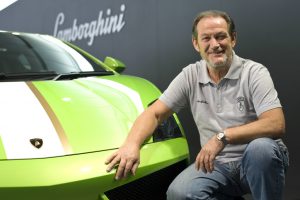
My name is Valentino Balboni, I was born on May 13th 1949 in Casumaro, Italy, where I still live to this day. I have three brothers. My parents, who have since passed away, lived all their lives in that same house. I started elementary school, then I moved 5 km farther to attend the truck repair school, which my dad chose as it was the most convenient.
My family was very modest – my father was a carpenter and craftsman, my mother was a housewife. My brothers worked in the ceramic industry. In the summer I worked in the fields, but as soon as I finished the mechanic’s school my father wanted me to work in that industry so I applied for a job at Lamborghini, where I started work as an apprentice in 1968. We apprentices were the assistants of the older mechanics, and slowly but surely I learned the trade and learned to drive cars, which had always been my passion.
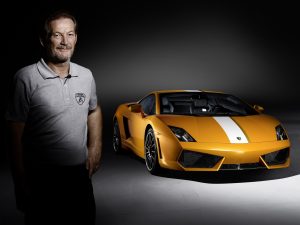 I drove the cars even when I wasn’t supposed to, around the factory – all excuses were good to drive the cars. As the company grew it took on two young test drivers or «collaudatori» and me and a colleague were chosen to become test pilots and grow together with the older test pilots, who taught us the trade.
I drove the cars even when I wasn’t supposed to, around the factory – all excuses were good to drive the cars. As the company grew it took on two young test drivers or «collaudatori» and me and a colleague were chosen to become test pilots and grow together with the older test pilots, who taught us the trade.
I became a regular test driver in 1973, I tested my first car on September 5th 1973. It was one of the last Miura SVs that were built in that period. After about a year of training with experienced test pilots, particularly the late Bob Wallace who was my mentor, teacher and instructor, I started testing production cars because it was obviously the easiest step to learn.
Later I began to test the customers’ cars at the Customer Service, where I worked as a mechanic. Testing cars is the best way to learn the job that I liked, not least because I learned to repair all models, the 350 and 400 GT, Espada, Miura, Diablo…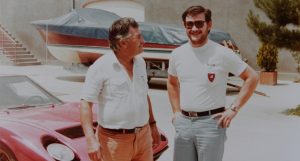
I matured as a mechanic and at the same time I could do testing, so it was very advantageous because I could nurture my passion for mechanics while at the same time growing professionally as a tester. In my opinion a good tester has to be a good mechanic, it makes it easier for you and it helps you understand so many things.
Over time I began to test experimental cars, prototypes that later became road cars. The first prototypes that I developed were the Diablo and the LM 002, which was an all-terrain vehicle. So I basically grew up professionally with the Diablo, the car that we developed together with the engineers; this is more or less the story…
When you started the young test drivers were under the tutelage of Bob Wallace ¿what other veteran testers were there?
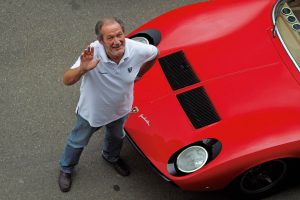 There was the late Cesare Lodi, who was also a production tester, there were others for brief periods, people who stayed for a few months and left, but we were the ones who were born and raised at Lamborghini, who spent their entire career at Lamborghini – Lodi, Pierluigi Mori and myself.
There was the late Cesare Lodi, who was also a production tester, there were others for brief periods, people who stayed for a few months and left, but we were the ones who were born and raised at Lamborghini, who spent their entire career at Lamborghini – Lodi, Pierluigi Mori and myself.
We tested production cars and customer service cars, customers’ cars that came back to Sant’Agata for warranties, repairs, periodic checks and services, because in those years there were not many authorized or specialized workshops, the external assistance network was only just starting to form.
In those years the internal assistance of the factory was the only assistance there was. This is broadly the story there: production, apprentice, mechanic, tester and then I went to research and development. As I advanced as a tester, I acted as a representative of the company at events and demonstrations. I was basically the spokesperson for Lamborghini, the representative that Lamborghini sent to those events to promote the product.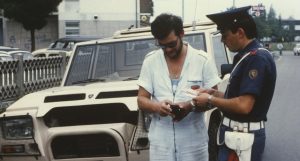
So you were a mechanic, tester, PR person, you were involved in all sectors
Exactly! That’s what I did for many years. In addition to the technical part I spent a lot of time on the image and public relations part.
From what I see in the photo you sent me you had a very close relationship with Mr. Lamborghini…
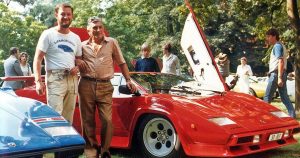 Yes, Ferruccio Lamborghini was our boss, but at the time the concept of «boss» was different from what it is nowadays. As well as being our employer, he was also very close to us mechanics, he knew how to motivate us, he knew how to give us that drive to be able to solve problems and think ahead. He was a very charismatic character who helped those who were willful and eager to learn to do things well. I was fortunate to grow very close to him and to master tester Bob Wallace, who was the best tester I have ever met.
Yes, Ferruccio Lamborghini was our boss, but at the time the concept of «boss» was different from what it is nowadays. As well as being our employer, he was also very close to us mechanics, he knew how to motivate us, he knew how to give us that drive to be able to solve problems and think ahead. He was a very charismatic character who helped those who were willful and eager to learn to do things well. I was fortunate to grow very close to him and to master tester Bob Wallace, who was the best tester I have ever met.
Yes, they described him to me as a nice person, a person who liked everyone and was loved by everyone. He was the type of boss who the workers love and look up to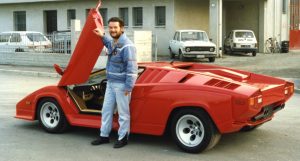
Exactly. He was charismatic, although he didn’t have a formal education. It is known that Ferruccio Lamborghini did everything he did in our area of Emilia Romagna, which at one point had five very large factories which employed 6000 local families. In Cento di Ferrara there were tractors, in Bologna there were hydraulic power and burners, in Sant’Agata the Lamborghini Automobili. Practically all the families in that area ate because Ferruccio Lamborghini gave them work.
¿What was his education level?
 Ferruccio Lamborghini’s family was a very poor family. He attended elementary school, but he knew very little Italian and he didn’t speak a word of a foreign language. He only spoke the Bolognese dialect. His mood, his temperament and his initiative led him to do what he did, building the Lamborghini factory as well as starting other factories. He had a great entrepreneurial spirit and a desire to do something unique and different from everyone else.
Ferruccio Lamborghini’s family was a very poor family. He attended elementary school, but he knew very little Italian and he didn’t speak a word of a foreign language. He only spoke the Bolognese dialect. His mood, his temperament and his initiative led him to do what he did, building the Lamborghini factory as well as starting other factories. He had a great entrepreneurial spirit and a desire to do something unique and different from everyone else.
¿Did I understand correctly, he didn’t speak Italian but only the local dialect?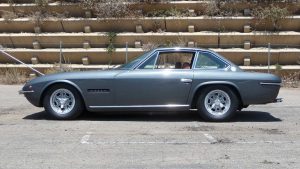
Hahahaha, that’s right! He spoke what little Italian was needed to make himself understood. He didn’t have an advanced formal education, but he had this special will and charisma that attracted people who had obviously studied more than him. He was the one who motivated them and told them what he wanted so that they could build it.
Engineers were hired right out of college because they cost less, but they were so motivated and eager to do things that it was better to hire young engineers than older engineers, who may have lacked motivation. A young engineer, according to Ferruccio Lamborghini, wanted to show the world that he knew how to do things, and that is indeed what always happened!
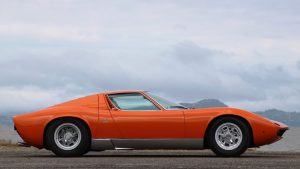 And that’s where the Miura came from, made by boys…
And that’s where the Miura came from, made by boys…
Yes! From there came the Miura that was made by the engineers Dallara, Stanzani, Pedrazzi, Bedini. A small group of five or six young people built the Miura myth and then later the Countach, the Espada and all the other cars that made the Lamborghini brand famous.
In my opinion the two quintessential sports cars in the collective imagination are the Miura and the Countach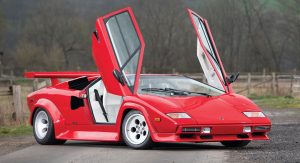
Hahaha, I would agree with that!
Maybe it’s a matter of taste, maybe for some people the Dino is more beautiful, but it is not impressive or spectacular like the Miura or the Countach
Exactly, Ferruccio Lamborghini always wanted to do things different, just think that when the Countach came out with the famous scissor doors that opened upwards it seemed like an impossible project, but he showed the world that it could be done. The Countach became an icon of motorsport history.
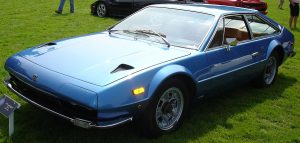 Today it is a car that is 50 years old and still leaves you breathless when you look at it
Today it is a car that is 50 years old and still leaves you breathless when you look at it
That’s true, it still has the power to amaze. When I try out a Miura or a Countach and stop in the town of Sant’Agata, where everyone knows Lamborghini, and where everyone has in one way or another participated in the success of Lamborghini because they have worked there, their children have worked there, and their grandchildren are working there, 50 or 100 people will gather around it in less than five minutes.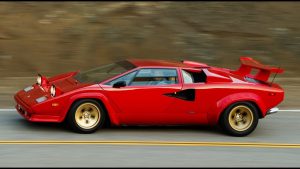
Everyone stops and everyone says: I did this, I did that, my son works there, my grandson works there, it is a wonderful experience to stand in that town with a car that belongs to that town and within seconds the traffic is blocked. People rush to see the car, each one says what they know about the car, what they experienced in the construction of the car. It is a wonderful feeling, the feeling that one of these 50-year-old cars can still excite and inspire. And if you go to another town 40 or 50 km away, you’ll find the same situation.
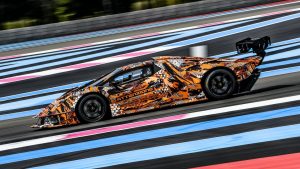 I can imagine! Tell us about your personal relationship with Ferruccio Lamborghini, what life was like in the factory, how you worked, what was the work methodology, the test methodology, how to understand a car, how to cure understeer and oversteer, how do you understand if the chassis twists or flexes, what the Miura, the Countach, the Espada were like. These are cars that have a reputation for being tremendously dangerous and could catch fire at any time – if you rolled the Countach you couldn’t get out because there was no way to open the doors, you burned inside the car…
I can imagine! Tell us about your personal relationship with Ferruccio Lamborghini, what life was like in the factory, how you worked, what was the work methodology, the test methodology, how to understand a car, how to cure understeer and oversteer, how do you understand if the chassis twists or flexes, what the Miura, the Countach, the Espada were like. These are cars that have a reputation for being tremendously dangerous and could catch fire at any time – if you rolled the Countach you couldn’t get out because there was no way to open the doors, you burned inside the car…
Let’s see which of those questions would you like me to talk about first? What was Ferruccio Lamborghini like?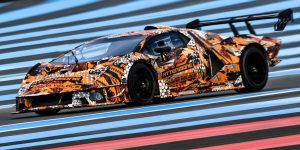
¿Yeah, how were things between you two?
We had a very direct and constructive relationship. He was not a boss, but a person who gave you the strength and motivation to do things the way they had to be done, with passion and love. You know, Ferruccio Lamborghini often entertained customers while we completed the cars. When you build a new car, especially the first cars you build, there are always delays, there is always something wrong. Ferruccio Lamborghini entertained the customers while we, the mechanics and apprentice mechanics, finished assembling the car and ironing out its flaws. Ferruccio was one of us. He was the owner of the company but also an enthusiastic salesman who promoted his product.
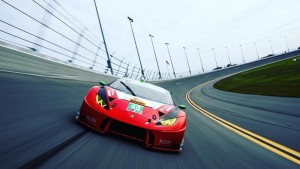 When the Miura was born, for weight and performance reasons it had a chassis that was 0.8 mm thick. When you mounted the engine and the suspensions, which were also rigid, the chassis obviously suffered from flexing, so when you braked very hard on a straight line, the chassis did not react as it should, as was foreseen in the design phase.
When the Miura was born, for weight and performance reasons it had a chassis that was 0.8 mm thick. When you mounted the engine and the suspensions, which were also rigid, the chassis obviously suffered from flexing, so when you braked very hard on a straight line, the chassis did not react as it should, as was foreseen in the design phase.
Instead of braking right, the car pulled to the right and to the left, because the chassis being weak had variations in the regulations and the camber of the suspension. The flexion of the chassis caused variations to the suspension settings, creating instability.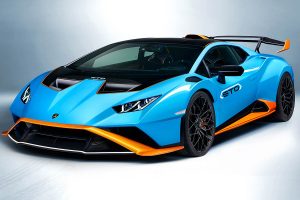
Also when you enter a curve and the chassis flexes a lot, it acquires an oversteer that is not controllable, especially with cars with a rear or a rear-mid engine. If the chassis bends a lot it causes oversteer, and the power oversteering expected by the builder is anomalous and can cause handling difficulties.
After the first 50 or 60 cars were built, we improved the entire chassis structure. From 0.8 mm thickness with 50 extra kilos of weight, we went to 1.2 mm, so the structure acquired the necessary rigidity to eliminate the instability that we had in the first versions. It was a big improvement from a technical point of view.
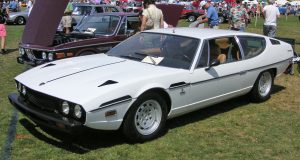
Every day modifications were made to each version to improve and eliminate situations that were unforeseen, defective, dangerous or unreliable, and this happened both for the chassis and for other components. There was a constant improvement in quality of all the components of the car. Whenever a problem arose we would work to solve it immediately, so some cars that had manifested problems in the assembly line no longer had them in subsequent versions.
¿So is it true what they told me, that practically every Lamborghini was a unique prototype? Because they made modifications to each car that the previous car did not have and in turn the next car had even more modifications, solving other problems…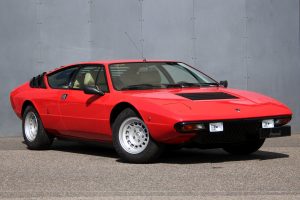
Correct! That is in fact what happened! It happened because it was required to improve the quality, safety and image, as well as to please individual customers.
When a car rocks in the middle of a curve, or lifts a wheel inside a curve ¿What does it mean, that the chassis flexes or are there other factors involved?
There are other things that can come into play, sometimes the geometries of the suspensions are not correctly studied. These are anomalies that are verified in extreme conditions. Having a wheel in the air means not having the expected stability.
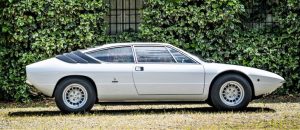 Miura, Countach, Jalpa, Urraco are all mid-engined cars ¿What was the basic behavior of the mid-engined Lamborghinis? Would they understeer or oversteer? What was it like to push a Miura or a Countach to the limit? And how about the latest SV and Quattrovalvole versions, the ones that were already evolved and not the first ones that had a lot of flaws?
Miura, Countach, Jalpa, Urraco are all mid-engined cars ¿What was the basic behavior of the mid-engined Lamborghinis? Would they understeer or oversteer? What was it like to push a Miura or a Countach to the limit? And how about the latest SV and Quattrovalvole versions, the ones that were already evolved and not the first ones that had a lot of flaws?
A fair observation. The Miura SV which was the last, built with 255/60 rear tires, having changed the suspension arms for double arms, had greatly improved stability and safety, the chassis at that point had been almost perfected, the wide tires at the rear eliminated 90% of the stability problems that could occur with the narrow tires.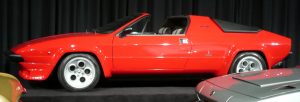
The problem at that time is that there were tires with very high profiles, which created the phenomenon of the “tire sweep”, whereby the tire worked a lot on its sidewall. The Miura and the Countach both had a rear mid engine, so this phenomenon of tire sweep created stability problems. Even on a straight there was always a constant oversteer. It was always necessary to control the car with small corrections on the steering wheel to prevent this oversteer from arising, which was due to rear weight and high-profile tires. This was partly improved when Pirelli replaced the high-profile tires of the Miura with low-profile tires.
¿So the Miura was a car that skidded even on the straight?
Let’s say the P400 was a car that had to be gripped hard on the straight. You had to handle it carefully. The SV was a car that rolled straight as an arrow, in turns some oversteer was expected, but it was pleasant and easy to control. The low-profile tires created this mild oversteer that was easily controllable by an accomplished driver who knew how to appreciate it.
To get an idea since I never drove a Countach or a Miura ¿How would those two vehicles behave in the «Curva Parabolica» of Monza?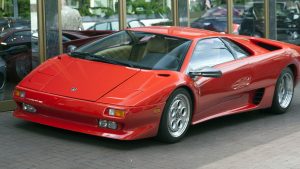
With the Miura P400 and the 0.8 mm chassis, you would have to accelerate at a constant rate, entering very fast, giving a little gas so as to not lose speed and keeping it constant. With the SV you could enter much faster, keeping a high speed until there is some understeer or nose “drag” which tends to lengthen the turn, then you ease the pressure on the gas pedal a bit to transfer some weight to the front wheels and the car would balance automatically.
At the Winfield Pilot School they taught me to brake at the end of the straight and hit the gas at the apex of the corner; at the Henry Morrogh School they taught me to brake hard at the end of the straight, cut in and do the whole corner in acceleration.¿Which is of these two techniques can be used with the Miura and Countach?
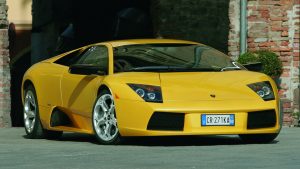 Let’s say the Miura SV with wide rear tires, the last version, I consider it to be neutral to the limit. The Countach tends to understeer. The last version with wide wheels, that is to say the «25th Anniversary» or the «Quattrovalvole», these Cars are neutral but when pushed to the limit a certain understeer will appear, so just release the gas a little and transfer a little weight forward to neutralize this phenomenon.
Let’s say the Miura SV with wide rear tires, the last version, I consider it to be neutral to the limit. The Countach tends to understeer. The last version with wide wheels, that is to say the «25th Anniversary» or the «Quattrovalvole», these Cars are neutral but when pushed to the limit a certain understeer will appear, so just release the gas a little and transfer a little weight forward to neutralize this phenomenon.
With the first Countach LP400 with narrow high-profile tires and a lot of rear weight, the oversteer was terrifying, you practically had to skid round corners in order to maintain a reasonable speed inside the curve. With later versions this phenomenon disappeared and there was actually more understeer, but it is something that occurs in the middle of the curve, never at the entrance of the curve. It is enough to stabilize the car and you can enter very quickly.
In other words, if I used the Winfield technique with these cars, I would go off the track…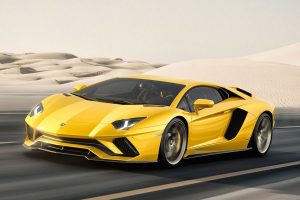
Right! I brake hard before entering a corner and as soon as I cross the steering wheel I keep my speed constant. When I go very fast and the front part slips I release the gas a little and re-enter the correct path.
¿Can we say then that all mid-engined Lamborghinis behave the same way?
That’s right.
And the Espada, Jarama, Islero, those with a front engine ¿How did they behave?
The same issue of the high-profile tires. When the Espada came out in 1969 there were 215 tires that had very poor grip. They were the best available at that time, but they were not the ideal tires. When we switched to the Michelin or the Pirelli Cinturato, changing the suspension geometry, the camber and the thickness of the torsion bars, which are very important when we have a high-profile tire, this changed the behavior of the car.
 With modern cars the torsion bar has a less relevant effect, because the low profiles of the tires do not feel the effect of the torsion bar quite as much, while the high-profile tires do. Therefore the Espada and Jarama first series, whose suspensions and kinematics were the same, although the Espada being longer had much more power oversteer, were improved by installing wider tires, with lower profiles and softer compounds. This improved the handling of these vehicles considerably, making them easier and more enjoyable to drive.
With modern cars the torsion bar has a less relevant effect, because the low profiles of the tires do not feel the effect of the torsion bar quite as much, while the high-profile tires do. Therefore the Espada and Jarama first series, whose suspensions and kinematics were the same, although the Espada being longer had much more power oversteer, were improved by installing wider tires, with lower profiles and softer compounds. This improved the handling of these vehicles considerably, making them easier and more enjoyable to drive.
We already talked about the technical part, the mechanical behavior of these cars, but ¿what was the feeling of driving them like? They say that the Countach was claustrophobic, that the Espada was too long, that the Miura rose ahead with the speed…
No no no… It is not true, I do not agree with that at all. Someone who gets into a powerful car like the ones we are talking about, has to adapt to the characteristics of each one of them. Each one has its own characteristics. It is obvious that if someone drives a Miura without knowing it and tries to push it to the limit straight away, he will have problems. But if a person has the sensitivity to get to know the car and understand its limits one step at a time, they can drive it perfectly.
The Miura never got off its nose, we never had problems with loss of front grip at high speed. These are myths. A long time ago a journalist wrote something like that and it became an urban legend. We have a gas tank in the front part that carries 90 litres, when it is full the car is very stable and when it is empty a little less so, but even at 270 km/h the car will remain stable and follow your commands. The driver must adapt to the characteristics of the car based on the situation.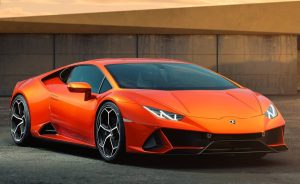
That’s why I wanted to interview you. There are too many lies and urban legends out there, from people who haven’t even seen a Lamborghini up close, let alone driven it. It’s better to ask someone who knows
Hahaha that’s very true! When we made the Diablo it had many problems. It had a great engine, powerful and elastic, but there were issues with the chassis, and here we practically relived the experience of the Miura at the beginning. However the Diablo was born many years later, it had suspension problems that they did not have, as well as an aerodynamic problem. When I was going fast the car would flatten in front, increase the squatting problem and rise from behind.
So we changed the inclination of the anti-squat and the anti-dive and we solved 90% of the problem. We changed the frequency of the coil springs and the adjustment of the shock absorbers, lifting the car 4 cm – this way we gained a stability even in the first Diablo that was exceptional, then with the second version of the Diablo, which was the VT or Viscotraction, with the electronic suspensions and the power steering, there were zero stability problems and a perfectly improved chassis.
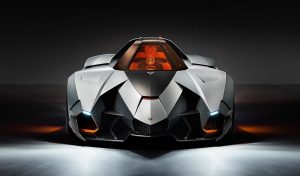 The balance was optimal. We switched from the ATE brakes, which were the best at the time when the Diablo came out, to the Brembo brakes, who told us they had special brakes for our car. We tested them and they were balanced and precise. Then in ’98 with the increase in size of the brakes and ABS we reached the optimum point, we couldn’t have done better with the materials available at the time.
The balance was optimal. We switched from the ATE brakes, which were the best at the time when the Diablo came out, to the Brembo brakes, who told us they had special brakes for our car. We tested them and they were balanced and precise. Then in ’98 with the increase in size of the brakes and ABS we reached the optimum point, we couldn’t have done better with the materials available at the time.
The chassis is essential in the tuning of the vehicle. If the chassis is good it is easy to develop the vehicle, if the chassis is not good it is not clear in which direction go with the car development, because it is a job that is done one component at a time. First you have to try one thing and then another, it is a technical conundrum that involves time and money.
¿What is the «anti-squat» and the «anti-dive»?
When you accelerate hard you will have noticed that the car crouches from the back. That is what they call the «Squat». The anti-squat is a suspension system mounted and developed in a certain way, which greatly reduces the phenomenon of crouching in acceleration. And it does not change the geometric condition of the suspensions. It does not go from negative zero of camber to two negative of camber, it stays at its optimum point and this is the anti-squat at the back.
The anti-dive works in the opposite way. When you brake very hard the nose of the car will lower considerably, because all the weight is transferred forward. The anti-dive then kicks in to reduce this phenomenon, and the geometric variations of the suspension are minimal, which maintains stability and optimal driving conditions.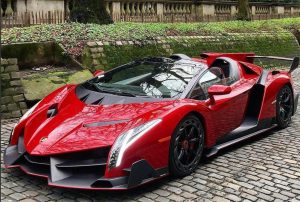
I remember in 1987 the prestigious North American program “60 Minutes” dedicated an episode to Lamborghini and you were interviewed. You were driving a white Countach and they asked you if you would dare to go at certain speeds and you said: with this car, yes…
Yes, I remember that very well! Hehehe, at that time we had the Countach Quattrovalvole, which already had an optimal set-up, it was a good compromise between chassis, suspensions, engine, power, brakes, tires etc. Going from the Countach LP400 to the Quattrovalvole is a world of difference, we are talking about a modern ultra-low tire, where there is practically no flex on the sidewalls and in the LP 400 we have a very high tire, where there is a huge “sweep” in the curve and this is essential for the stability of the car.
They said that the Countach had a very hard gearbox, very hard steering, and a very hard clutch ¿Is that true?
 It is true, but these must be seen as characteristics rather than a defect. It is clear that in the Countach we never put power steering, and it is clear that when I do a maneuver with 235/35 tires at the front, they leave a gigantic mark on the asphalt. When I have to make parking maneuvers and I have to cross to the right and to the left at low speed, it is hard and tiring and makes you sweat, but you’ve got to know how to appreciate it.
It is true, but these must be seen as characteristics rather than a defect. It is clear that in the Countach we never put power steering, and it is clear that when I do a maneuver with 235/35 tires at the front, they leave a gigantic mark on the asphalt. When I have to make parking maneuvers and I have to cross to the right and to the left at low speed, it is hard and tiring and makes you sweat, but you’ve got to know how to appreciate it.
I do not see a defect or a handicap, just a peculiarity. Parking is very hard but when moving the steering becomes light and pleasant to use, very direct, very precise and it reflects the characteristics we wanted from the car. The clutch was hard, it is true, we could have made it softer, but we had 450 horsepower to transmit to two rear wheels with very low profiles; bringing this power to the rear wheels requires a clutch with exaggerated springs.
It is obvious that with the spaces that exist in sports cars, certain other advantages must be given up. A mechanical clutch that has to carry 450 horsepower on two wheels, has to have a certain specific pressure between the clutch plate, pressure plate, clutch collar and the flywheel of the motor, and this load has to go to the pedal. Although all the angles of the levers and all the various situations were optimized, you could not get more than what you got. Of course the clutch was hard, but there were women who drove the Countach, they sometimes complained that the steering and clutch were tough, but they drove it and were happy.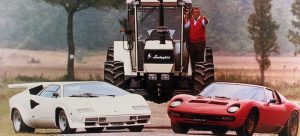
Let’s talk about the Viscotraction or VT. Some people say that the two-wheel drive were better because the four-wheel drive caused a lot of understeer ¿Is it true or not?
I like that you asked this question. When in ’92 we started making the Diablo with a viscous coupling differential and four-wheel drive, I was one of those who said that we absolutely shouldn’t make such a sports car with all-wheel drive. As we progressed, with the tests we did for the tuning of the viscous coupling I had to completely change my opinion. I am not ashamed to admit that at first I was against the 4×4 traction.
Later I was convinced that they had made a good decision, because the stability and cornering speed of the Diablo with the VT is something that tears your head off your neck. I was never sorry to admit that I was wrong. At first I thought that a sports vehicle needed rear wheel drive to be able to skid and spin, and that with all-wheel drive this would not be possible, but I realized that it was equally possible to do the same thing that is done with only two driving wheels, but with a much higher limit.
 I mean, this car even being a Viscotraction ¿Does it work like a normal and ordinary rear wheel drive?
I mean, this car even being a Viscotraction ¿Does it work like a normal and ordinary rear wheel drive?
Yes! But corners I would usually skid through at, say, 80 km/h, with all-wheel drive I can do at 140 km/h. I can go much faster and the car does not skid, it’s as if it was on rails. The all-wheel drive has brought great advantages and has not taken away the pleasure of driving the car, of playing with the car, the sensations it gives you are still very good. With the Viscotraction you can take any corner 40 km/h faster than with the normal Diablo, without getting into trouble.
In other words, Audi did not stifle Lamborghini’s nature. It remains a raging bull…
Let’s say this system was developed by Lamborghini, we had it before Audi came along. When Audi bought Lamborghini they saw our system but never touched it, it’s a hundred percent a Lamborghini system. Many people believed that all-wheel drive was Audi technology, but Audi never messed with our cars, they started to intervene a bit with the latest versions of the Murcielago, but other than that they never intervened in the technical area of our cars.
¿And how about the latest Lamborghinis, are they like those created by Ferruccio? are they something else?
I would say that they preserve the Lamborghini spirit but ultimately they are something else. The technologies applied to a car today are completely different from what we had available all those years ago. The cars retain their extraordinary exclusivity, but the handling is so easy now that I don’t know how much the driver can actually enjoy. Driving a Countach at 200 km/h is much more exciting than driving an Aventador at 300 km/h, if you see what I mean.
I can only imagine it…
Hahahahaha, the Aventador and the Huracán have enormous power, they are super safe cars, with perfect suspensions and exceptional brakes, they are very sophisticated and very pleasant to drive, but I can say that driving a Countach provokes very different emotions than when you have a paddle-shift and automatic clutch. I grew up with the concept of the true sports car.
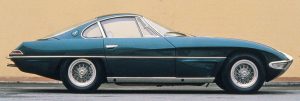 I adore and respect these modern cars, every time I drive an Aventador or a Huracán I say mamma mia, what great cars! Comparing the modern cars to the classics is like comparing two different worlds. One thing I can say is that I would never change my experience as a tester with that of today’s testers who test-drive the Huracans, Aventadors and so on.
I adore and respect these modern cars, every time I drive an Aventador or a Huracán I say mamma mia, what great cars! Comparing the modern cars to the classics is like comparing two different worlds. One thing I can say is that I would never change my experience as a tester with that of today’s testers who test-drive the Huracans, Aventadors and so on.
We talk about the hybrid, about the electric motor that gives you 30 more horsepower, these are things that I share and respect, but later I retrace my steps and I always tell myself that I was fortunate to live the most beautiful moments, which for me were those of the Lamborghini Miura or Countach.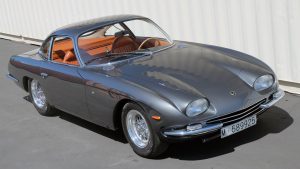
¿Is it true that Ferruccio Lamborghini never wanted his cars to participate in races?
Ferruccio Lamborghini used to say that he would never build a racing car, it costs a fortune to do so. He said: I can promote and sell my cars because I make them so well, I don’t need a racing pedigree to be able to sell them. He never agreed with the “racing” aspect to promote cars, he said that it is not worth investing millions to build a competitive racing car in order to sustain sales.
¿Any story that nobody knows about Ferruccio Lamborghini?
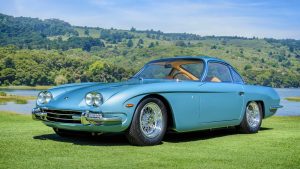 Lamborghini at the beginning of his industrial career bought two Ferraris, a white one for his wife and a black one for himself. When customers came to buy tractors, he took them to lunch in his Ferrari, but he always burned the clutch because he liked to make Formula-type starts. Once he went to Maranello to Ferrari to have the clutch fixed and he was shocked at how expensive it was.
Lamborghini at the beginning of his industrial career bought two Ferraris, a white one for his wife and a black one for himself. When customers came to buy tractors, he took them to lunch in his Ferrari, but he always burned the clutch because he liked to make Formula-type starts. Once he went to Maranello to Ferrari to have the clutch fixed and he was shocked at how expensive it was.
He went once, twice, three times, until one day he decided that the tractor mechanics could fix the clutch at his factory. One of them, a great friend of mine who has since passed away, realized that the clutch plate and the pressure plate of that clutch were the same as those of a small Lamborghini tractor, so they called Ferruccio over to take a look.
They showed him the burnt-out clutch of his Ferrari and the new clutch of the Lamborghini tractor, laid out on the work table. They were exactly the same. It was a commercial part, used by Maserati and others, I think it was a Borg & Beck or a Sachs, I don’t remember well. When Ferruccio saw that, he was furious and started shouting: That guy has charged me 100 for something that costs five, he cheated me!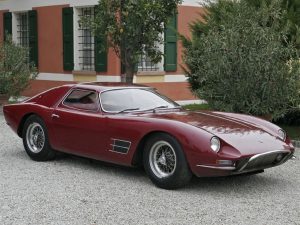
Some time later Lamborghini and Ferrari met at an Agricultural Fair in Verona, they started talking and Lamborghini told Ferrari: You build your beautiful cars with the clutches of my tractors. Ferrari got furious and told him: You are a peasant! drive your tractors! you have no right to judge my cars!
There are tape recordings from the time where Ferruccio Lamborghini says: He told me that I am a peasant and that I am not capable of driving his cars, so I told him: I will show you how to build a sports car that does not have defects like yours! That was when Ferruccio began to build his cars. This was told to me by my friend, the man who changed the clutch on that first car, the late Vito Fornasieri. He was also from my town Casumaro.
¿Are you still working or retired?
I retired in 2008 and for a further six years I was a Lamborghini consultant. The day after I retired I was hired as a consultant. Today I am an independent, free-lance consultant, although I do not dedicate myself to other brands but rather to restoring the cars that I built together with some retired friends from that time. Basically the cars we built new at that time we restore today.
I wanted to transcribe this interview in its entirety, word for word, and translate it literally without changing anything, so that the reader can get an idea of the sympathy and simplicity of this man who has the gift of mechanics and handling, who breaks bread with princes, kings, stars and industrialists who entrust their Lamborghinis to him to be restored, repaired or tested, but who remains forever humble.
Thank you Valentino!!
Other published articles: https://www.quepasa.com.ve/seccion/columnistas/grand-prix/
Mi YouTube channel: https://www.youtube.com/user/salvadorfazio
Instagram: @grandprixconsalvadorfazio


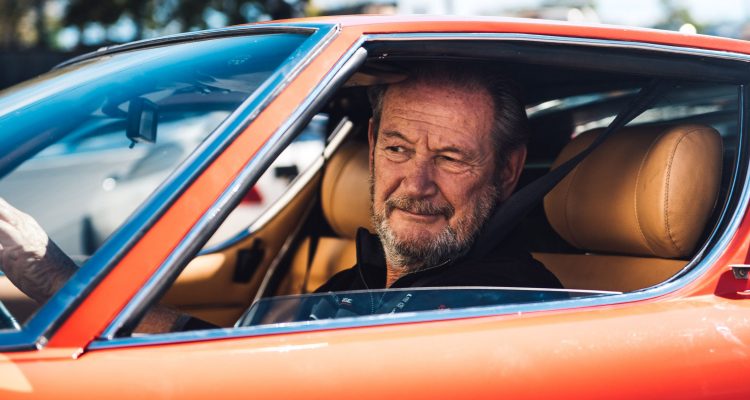
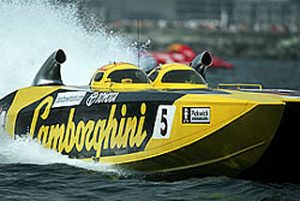
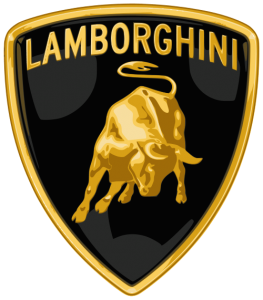






Comente